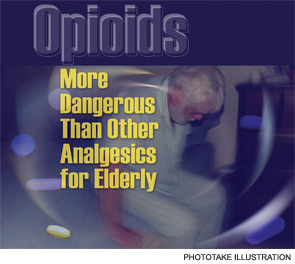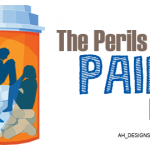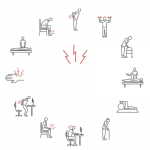
In the past few years, the use of opioids to treat arthritis pain has increased dramatically because of concerns with the risk of cardiovascular disease and other side effects with nonselective, nonsteroidal antiinflammatory drugs (nsNSAIDs) and selective cyclooxygenase-2 inhibitors (coxibs). Despite the widespread use of these agent, there have been few data available on the comparative safety profile of opioids. Now, two studies by Solomon et al published in the Archives of Internal Medicine show that elderly patients who take the narcotic-based drugs are at higher risk of cardiovascular disease, fractures, and death when compared with individuals taking nsNSAIDs and coxibs.1,2
“We were motivated to study this area because of a dramatic increase in opioid use and professional society recommendations, but there was a general lack of data about the comparative safety of opioids in older adults,” says lead author Daniel Hal Solomon, MD, MPH, associate professor of medicine in the Division of Pharmacoepidemiology and Rheumatology at Brigham and Women’s Hospital at Harvard University in Boston. Dr. Solomon is also a member of the Editorial Board of The Rheumatologist.
The researchers studied the claims database of 12,840 Medicare patients in Pennsylvania and New Jersey from 1999 through 2005, comparing the use of nsNSAIDs, coxibs, and opioids. The patients in this study had been diagnosed with either rheumatoid arthritis or osteoarthritis. Safety events reviewed included cardiovascular problems (myocardial infarction, stroke, heart failure, revascularization, and out-of-hospital cardiac death), gastrointestinal tract outcomes (upper and lower gastrointestinal-tract bleeding and bowel obstruction), acute kidney injury (including hospitalizations for acute renal failure requiring dialysis), hepatic toxic effects (including inpatient and outpatient events), fractures (hip, pelvis, wrist, and humerus, but not spine), and trauma denoting a fall.
The Results
“In a cohort of older adults with arthritis, opioid users experienced the highest risk across most specific and severe safety events and nsNSAID users the lowest risk,” the authors wrote in the article titled, “The Comparative Safety of Analgesics in Older Adults with Arthritis.” “The three composite severe safety events that we defined—events leading to hospitalization, events associated with death, and all-cause mortality—mirror serious adverse events as defined by the U.S. Food and Drug Administration [FDA].”
In an invited commentary that followed this first article, Jonathan Graf, MD, assistant adjunct professor of medicine at the University of California, San Francisco, noted that, “evidence suggests that the greatest increase in prescriptions for opioids is occurring in women with chronic pain who are older than 65 years … Use of opioids is potentially problematic in this particular population that is more prone to cognitive impairment, falls, and respiratory depression, which is why the study of Solomon et al is of particular interest.”3
Dr. Graf also wrote that, “given the controversy already surrounding the relationship between coxibs and myocardial infarction, the excess MI risk found for users of opioids is quite thought provoking.” He noted that the statistically significant increase in all-cause mortality for patients taking opioids compared with those taking nsNSAIDs was concerning, while there was no significant difference in mortality between patients who used coxibs and those who used nsNSAIDs.
Second Study with a Twist
In their second article, “The Comparative Safety of Opioids for Nonmalignant Pain in Older Adults,” Solomon et al used a propensity-matched cohort analysis of healthcare and pharmacy insurance data collected between January 1, 1996, and December 31, 2005, for 6,275 patients taking one of five opioids: hydrocodone, codeine, oxycodone, propoxyphene, or tramadol.2
“We found that risk was not monolithic,” says Dr. Solomon. “They have different pharmacokinetics, metabolites, and pharmacodynamics. This appears to translate into different opioids having different toxicity profiles. This is very much in line with what the FDA said in November when they pulled propoxyphene. Their conclusion was that propoxyphene is associated with greater cardiovascular risk than other opioids, and we found in our study that propoxyphene was one of the riskier opioids in terms of cardiovascular toxicity.”
However, he points out, propoxyphene wasn’t the riskiest; codeine had higher relative risk of cardiovascular disease.
The authors note that the reduced risk of fracture among tramadol users compared with hydrocodone users is also a novel finding. “Opioids may cause fractures through at least two mechanisms—an increased risk of falls and an effect of opioids on bone metabolism through sex hormones,” they wrote, stating that “the increased all-cause mortality we observed for codeine and oxycodone users may relate to cardiovascular events or other unmeasured cofounders.”
In an invited commentary for this article, William C. Becker, MD, and Patrick G. O’Connor, MD, both in General Internal Medicine at Yale University School of Medicine in New Haven, Conn., noted that “prudent patient selection, thorough patient education surrounding safe medication-taking practices, and frequent patient monitoring can mitigate the incidence of overdose, addiction and diversion … . For elderly patients, in whom intentional misuse of opioid analgesics is less prevalent and medical comorbidities such as gastrointestinal or renal disease constraining the use of other analgesics is more common, experts promote opioid use as safe and effective for chronic noncancer pain.”3
They added that there are two significant implications of the study: the need to reexamine the widespread use of codeine and to implement basic safety measures to avoid fractures.
Dr. Solomon said the take-home message of the two articles is “that opioids should not be considered safer alternatives to nsNSAIDs and coxibs. And, all opioids are not alike. I believe this is one of the first papers to examine the range of adverse events, but in the next year, we’ll see a lot more information about the comparative safety of opioids across different safety endpoints.”
Sue Pondrom is a medical journalist based in San Diego.
References
- Solomon DH, Rassen JA, Glynn RJ, Lee J, Levin R, Schneeweiss S. The comparative safety of analgesics in older adults with arthritis. Arch Intern Med. 2010;170:1968-1978.
- Solomon DH, Rassen JA, Glynn RJ, et al. The comparative safety of opioids for nonmalignant pain in older adults. Arch Intern Med. 2010;170:1979-1986.
- Graf J. Analgesic use in the elderly: The “pain” and simple truth: Comment on “The comparative safety of analgesics in older adults with arthritis, and the safety of opioid analgesics in the elderly.” Arch Intern Med. 2010;170:1976-1978.
- Becker WC, O’Connor PG. The safety of opioid analgesics in the elderly. Arch Intern Med. 2010;170:1986-1988.


